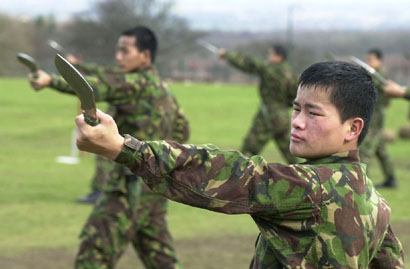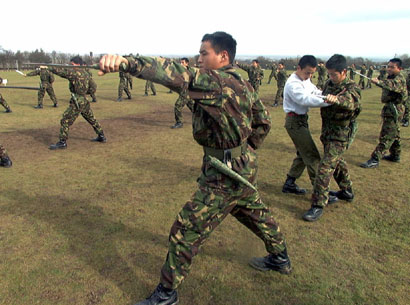
Crown Copyright

Crown Copyright

Crown Copyright

Crown Copyright
The pictures above are provided courtesy of the British Army Picture Library. They depict Gurkha recruits training with khukuris during week six of their basic infantry training at Catterick Army Base, North Yorkshire, UK. These pictures demonstrate that some formal military training with the khukuri currently exists. HW - 5/01
One evening, in the hills of Nepal a couple of days north of Kathmandu, I observed a woman slicing potatoes for the evening meal. She was using a khukuri for the task.
A full sized khukuri is not the tool of choice for slicing potatoes. Nevertheless, she was doing pretty well. She was slicing on a tall round of wood, so her hand could be below the plane of the chopping block. She was slicing them up as quickly as I do when I'm in the kitchen, but it was fairly obvious that she would loose a potato slicing race with a French chef using a chef’s knife.
She was probably using the only knife she owned. As I began to ponder what else she could make that khukuri do, my thoughts went back to the other people I had seen using them. People cutting bamboo, butchering chickens, splitting firewood, preparing food. She could probably use her tool as effectively for any of those jobs. Could she fight with it? A quick glance up at her face reassured me that she was still smiling. Good thing, because I doubt I could have outrun her.
Howard Wallace 2/20/99
When one grows up using a khukuri out of necessity one learns how to use it well. And, in the hands of a highly motivated user the khukuri, like any tool such as an axe, screwdriver or hammer, can quickly turn into a very effective weapon.
BILL MARTINO 2/21/99
As Pala mentioned most of his Gorkha service was devoted to keeping the
integrity of international borders and a few special ops assignments because
of his language ability.
Pala's usual confrontations were with people wanting to jump the border or
smuggle contraband. His job was simply to stop them. Most of the time a fellow
in Gorkha garb with an M-3 and khukuri who says "you can't do this" was enough.
On a few occasions where profit from smuggling was high enough they might
argue the issue. Pala couldn't draw down on them and shoot them so he would
draw the khukuri and say again, "you are not going to do this." Killing a
man and chopping off a limb are two completely different things. Pala had
developed the mind set, looked the guy right in the eyes, and made his stand.
As Pala puts it, "lucky for me maybe they all ran away."
BILL MARTINO
My khukuri self defense consisted of a strong offense of only three moves -- a head strike, gut strike, or leg strike. I always looked into the eyes of the opponent because they seemed to tell me what he was going to do -- perhaps lucky for me he always ran away. And, I conditioned my thinking to make myself to be willing to trade up -- I would trade a finger for a hand, a hand for an arm, and, of course, an arm for a head.
KAMI SHERPA
I have several customers who carry a khukuri concealed for defensive purposes. Every man has made or had made a shoulder rig which allows him to carry the knife under his arm, under a jacket. The usual khukuri of choice for this purpose is a 12 inch Sirupati.
When Yangdu was a young girl and used to travel to India to visit relatives she would ride what is called the "night bus." The male passengers would often try to become amorous with female passengers during the darkness of night so Yangdu would always tape a small 9 inch khukuri to the inside of her thigh. If she was approached she would reach under her anghi (long Sherpa dress) and whip out her little khukuri. Her stock phrase was, "if you want to keep that hand then keep it off me."
BILL MARTINO
The kukri, a short, curved, broad-bladed, and heavy knife, is the real
weapon of the Gurkas, and it is worn by all from the highest to the lowest.
In out regiments they are carried in a frog attached to the waist-belt.
From the beginning of the handle to the end, or spear point of the blade
they average about 20 inches in length.
Where wood is plentiful, they are very fond of practicing cutting with the
kukri, and they will cut down with one blow a tree the size of an ordinary
man's arm.
A really skillful cutter will cut off slice after slice from the end of a
piece of green wood, each slice being thicker than an ordinary piece of shoe
leather. They call this 'chinnu', 'to slice off'.
Vansittart (circa 1890 )
Before I begin about the battle worthiness of the khukuri, I would like to say several important things. First of all even in special forces operations, field knives are used 99-100% of the time for mundane tasks such as bush clearing, shelter buiding, firewood gathering, opening crates and cans, and as a pry bar. A well-made khukuri is excellent for all of this. Secondly one tends to fight best with the weapons one frequently trains with. If you are a revolver shooter and someone hands you a $3,000 custom 1911, you won't shoot it as well as the revolver until you practice sufficiently with it. The same goes with fighting knives (IMO).
As I don't know how much training background you have in stopping determined attackers, I will talk a little bit about how such people are usually stopped along with the khukuri's fighting assets.
1. Severing the spinal column is usually the most reliable way to stop a determined attacker. Whatever is below this area is paralyzed. The neck is the best area as this paralyzes the arms. Because of the curved blade, the khukuri excells at this. Lower hits will cause a person to fall down, thus making them an easier target. The khukuri, as well as any heavy (1+ lbs.) slashing blade does this job very well.
2. Smashing the skull if done with a heavy blow will,at the least, usually stun if not stop an opponent. Howver I don't know how it might affect large animals like bears, etc. But if such an opportunity presents itself, the khukuri will do a good job--as will any heavy blade.
3. Severing or breaking shoulder bones and limbs are also good ways to stop or at least slow down a fight. A severed limb is enough to make any but the toughest, most determined opponent stop. If it doesn't, the loss of blood will lower the blood pressure in 3-4 minutes so that the brain will not receive oxygen, and the oponent will pass out. Smashed bones also disable tactical necessities like hands an feet. The khukuri's curved blade excels at dismemberment. However any sharp heavy blade will do the job also.
3. Making wounds (thrust or slash) that will result in rapid blood loss. Slashing major veins and arteries can be done with any knife, but the heavier and longer the knife, the better. The khukuri's curved blade excells at this. All heavy knives do well also. However one of the most deadly moves in a knife fight is the reverse cut; this is where long heavy Bowie knives and naval cutlasses dominate. A reverse move can also be done with a khukuri, but because of its dull spine, it will only break or smash bone; whereas a heavy double bladed knife can cut deeply and perhaps even can severe a limb.
Thrusting deep into vital organs will also cause severe blood loss. This puts the khukuri at a slight disadvantage. Because the tip is significantly lower that the line of thrust, it is harder to hit the exact spot being aimed at. Again bowie knives, cutlasses, parangs, etc. do this job more easily. However the khukuri is not at such a disadvantage as many think it is. When I spar with others and make a thrust, the point I am aiming at is seldom there as my rubber bladed knife tip makes contact with my adversary's skin. However when I use my real khukuri and quick thrust at a marked point on a box, I find that the point is an inch or so off, whereas while using a straight blade, I almost always hit the spot I aiming for. However in the heat of battle, I think this might be a moot point.
I have also seen khukuris penetrate Level IIA body armor with a hard thrust, but of course, it couldn't slash itself through--but then neither could a full-size sword.
Lone Tree 11/01
Hello to All:Well I'm going to try to explain how I draw the Kuk.PLEASE
READ ALL BEFORE YOU START.
First; from now on every time you pull the knife from the scabbard you must
be aware,of the feel on the back of the blade, as it slides against the back
of the scabbard. To me it's like scraping the scabbard off of the khukuri,
you'll see what I mean.
1) Put the Khukuri on your belt some where on or near your back pocket (if
you go to the GORKHA GALLERY look at the pics you'll see how they wear it).
2) Listen to your Uncle Bill and stand sideways in font of a mirror and far
enough away so you won't hit the thing when you draw.
3) Reach around and grab the handle and pull it toward the draw hand by twisting
the belt loop. At this point the K is horizontal (parallel to the floor)
with the back of the scabbard pressing against you.
4) Now with the feeling of scraping the scabbard off the K draw. Feel the
back of the K slide against the back of the scabbard (THIS FEEL IS THE ONLY
WAY YOU CAN BE 100% SURE THAT THE EDGE IS NOT CUTTING OUT REMEMBER THIS ACTION
IS OUT OF YOUR SIGHT BUT NOT OUT OF YOUR TOUCH) all the way to the tip. When
the blade clears the scabbard drop the elbow and raise the K as if ready
to chop. Look in the mirror the whole time.
5) Then slide the K back in feel the back of the blade slide.
OK THAT'S IT!
PLEASE GO SLOW
WHEN YOU FIRST TRY USE A 3 COUNT
1-grab K
2-twist sacabbard (K- hoizontal)
3-draw out to the ready
AFTER A SHORT TIME YOU CAN USE A 2 COUNT
1-grab the K twist the sacabbard
2-draw out to the ready
GOOD LUCK and BE CAREFULL
------------------
Ray
Copyright (c) 1999-2001 by Howard Wallace / 2002-2003
by Himalayan Imports,
all rights reserved. maintained by Benjamin Slade.
This FAQ may not be included in commercial collections or
compilations, or distributed for financial gain, without express written permission
from the author. This FAQ may be printed and distributed for personal
non-commercial, non-profit usage, or as class material, as long as there
is no charge, except to cover materials, and as long as this copyright notice
is included.